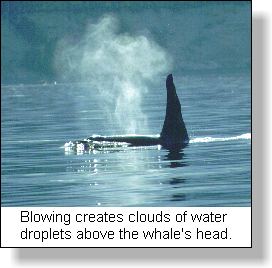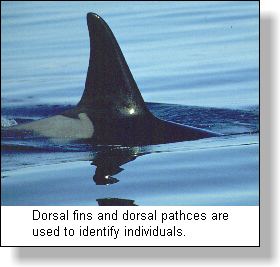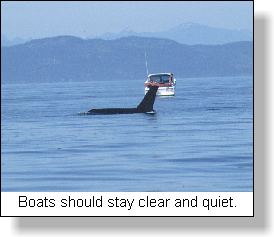
B.C. OUTDOOR ODYSSEY
"Killer Whale Encounters"
with Barry M. Thornton
 As a sports fisher I have been
fortunate to have had a number of encounters with Killer
Whales while on coastal waters. Many have occurredin the
calm northern area of the Strait of Georgia, south and east of Hornby Island, and south of
Quadra Island, while others have occurred in the mystical
wild waters of Johnstone Strait. The most dramatic
happened in Johnstone Strait one August when I was
canoeing to the estuary of the Eve river to fly fish for
pink salmon.
My partner and I had launched my canoe
at a logging company's dryland log sort, about two miles
from the river estuary, during an extreme low tide. Our
paddling route followed the edge of the deep drop-off
ledge along the intertidal beach. As we neared the river
mouth, a school of salmon showed on the surface in front
of us. I suggested to my partner that he pick up his fly
rod and cast to these fish. I was in the stern of the
canoe and could better manoeuvre it for his presentation.
On his third cast a powerful coho took the fly and began
such an aerial display, that I told him I was going to
beach the canoe to make it easier to fight this
particular flashy salmon. The intertidal beach was only a
few meters away even though we were over the drop-off,
with the result that it only took me moments to beach the
canoe bow on sand. But, as soon as I beached the canoe,
our two Brittany spaniels, who had romped and followed us
along the beach, leaped in the canoe with their spaniel
greetings resulting in massive confusion for a few
moments.
 It seemed that just as we calmed the dogs, a
deep resonating 'whooooshing' sound bombarded us as two
hunting Killer Whales, dorsal fins close enough to hook
with a cast fly, assaulted the same school of salmon.
They were that close and they were that massive! It seemed that just as we calmed the dogs, a
deep resonating 'whooooshing' sound bombarded us as two
hunting Killer Whales, dorsal fins close enough to hook
with a cast fly, assaulted the same school of salmon.
They were that close and they were that massive!
We simply stood in awe as a feeding
carnage occurred immediately in front of us. Then, almost
as quickly as it occurred, all was silent. Even the dogs
had been so overwhelmed that they forgot to bark.
Such being the will of the fisher, my
able partner, and I still to this day do not know how,
held onto the hooked but running coho. He told me later
that he simply let the fish run. It appeared that there
was sufficient backing on the reel to keep the coho
further down the shore and away from the pink salmon
school upon which the Killer Whales were feeding.
Later that same day we again witnessed
this hunting pair of orcas as they herded schools of pink
salmon into the low summer waters of the river. Once, as
the tide began to flood in earnest, one Killer whale
actually swam up into the shallow channel after a
panicking school of salmon, and then, turned just as it
shallowed on a small sand bar. That raw experience
remains as strong today as if it were just yesterday.
Do Killer whales, often called
'Blackfish' by salmon sports fishers, scare away salmon?
This is a common myth which likely has much truth
particularly for deep swimming chinook, which are their
most common summer food. However, it has been my
experiences, and there have been a number, that salmon
have not stopped striking when a pod of orca have cruised
past. Granted, I am usually targeting coho in my salmon
fishing but, I have had situations where chinook have
remained on the bite even after the Blackfish have come
and gone.
According to the Parks Branch, Killer
whales or orca inhabit all oceans. In British Columbia it
is estimated that over 600 whales inhabit our coastal
waters. These have been separated into two divisions, the
northern residents who inhabit waters from Johnstone
Strait north to the Alaska panhandle and, the southern
residents who live in the Strait of Georgia, Puget Sound
and Juan de Fuca waters.
 Killer whales are classified as either resident
or transient. Resident killer whales appear to feed only
on fish with the result that they are frequently observed
during the summer and fall as they pursue migrating
salmon. Transient Killer whales on the other hand are the
"killer of whales' for which they have been named.
Transients depend on warm-blooded prey including whales,
seals, porpoises and sea-lions. Killer whales are classified as either resident
or transient. Resident killer whales appear to feed only
on fish with the result that they are frequently observed
during the summer and fall as they pursue migrating
salmon. Transient Killer whales on the other hand are the
"killer of whales' for which they have been named.
Transients depend on warm-blooded prey including whales,
seals, porpoises and sea-lions.
Photo identification of Killer whales
has resulted in a much greater understanding of the
habits and social structures of these monarchs of the
ocean predators. High quality black and white photos are
used to identify each whale by the markings and nicks on
their dorsal fin and, by the saddle patch behind the fin.
Under the Fisheries Act, the Department
of Fisheries & Oceans is responsible for the
management and protection of Killer whales. Guidelines
for watching Killer whales suggest that you,
"approach no closer than 100 metres and shift your
motor into neutral or idle. Keep noise levels down - no
horns, whistles or racing motors. Leave the area slowly,
gradually accelerating when more than 300 metres from the
whales"
Those who are fortunate enough to see
Killer whales are requested to report all sightings to
Marine Mammal Research Group at 1-800-665-5939.
 Killer whales were once thought to be vicious
predators and were the victims of indiscriminate killing.
In recent years however, as we have come to understand
their importance in the complex west coast aquatic
ecosystem, they are now viewed with near reverence. To
see these gigantic creatures in our coastal wilderness
fiords is an experience never forgotten. Killer whales were once thought to be vicious
predators and were the victims of indiscriminate killing.
In recent years however, as we have come to understand
their importance in the complex west coast aquatic
ecosystem, they are now viewed with near reverence. To
see these gigantic creatures in our coastal wilderness
fiords is an experience never forgotten.
© Copyright Barry M. Thornton
Barry M. Thornton
| 




 It seemed that just as we calmed the dogs, a
deep resonating 'whooooshing' sound bombarded us as two
hunting Killer Whales, dorsal fins close enough to hook
with a cast fly, assaulted the same school of salmon.
They were that close and they were that massive!
It seemed that just as we calmed the dogs, a
deep resonating 'whooooshing' sound bombarded us as two
hunting Killer Whales, dorsal fins close enough to hook
with a cast fly, assaulted the same school of salmon.
They were that close and they were that massive!  Killer whales are classified as either resident
or transient. Resident killer whales appear to feed only
on fish with the result that they are frequently observed
during the summer and fall as they pursue migrating
salmon. Transient Killer whales on the other hand are the
"killer of whales' for which they have been named.
Transients depend on warm-blooded prey including whales,
seals, porpoises and sea-lions.
Killer whales are classified as either resident
or transient. Resident killer whales appear to feed only
on fish with the result that they are frequently observed
during the summer and fall as they pursue migrating
salmon. Transient Killer whales on the other hand are the
"killer of whales' for which they have been named.
Transients depend on warm-blooded prey including whales,
seals, porpoises and sea-lions.  Killer whales were once thought to be vicious
predators and were the victims of indiscriminate killing.
In recent years however, as we have come to understand
their importance in the complex west coast aquatic
ecosystem, they are now viewed with near reverence. To
see these gigantic creatures in our coastal wilderness
fiords is an experience never forgotten.
Killer whales were once thought to be vicious
predators and were the victims of indiscriminate killing.
In recent years however, as we have come to understand
their importance in the complex west coast aquatic
ecosystem, they are now viewed with near reverence. To
see these gigantic creatures in our coastal wilderness
fiords is an experience never forgotten.